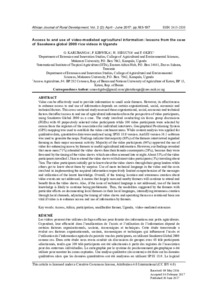| dc.contributor.author | Karubanga, G. |
| dc.contributor.author | Kibwika, P. |
| dc.contributor.author | Sseguya, H. |
| dc.contributor.author | Okry, F. |
| dc.date.accessioned | 2019-12-04T11:10:15Z |
| dc.date.available | 2019-12-04T11:10:15Z |
| dc.date.issued | 2017-04 |
| dc.identifier.citation | Karubanga, G., Kibwika, P., Sseguya, H. & Okry, F. (2017). Access to and use of video-mediated agricultural information: lessons from the case of Sasakawa global 2000 rice videos in Uganda. African Journal of Rural Development, 2(2), 183-197. |
| dc.identifier.issn | 2415-2838 |
| dc.identifier.uri | https://hdl.handle.net/20.500.12478/2048 |
| dc.description | Published: 30 June 2017 |
| dc.description.abstract | Video can be effectively used to provide information to small scale farmers. However, its effectiveness to enhance access to and use of information depends on certain organizational, social, economic and technical factors. This cross-sectional study assessed these organizational, social, economic and technical factors that affect access to and use of agricultural information from the perspective of video participants, using Sasakawa Global 2000 as a case. The study involved conducting six focus group discussions (FGDs) with 48 purposively selected video participants while 100 video participants were selected by census from the registers of the association for individual interviews. Geographical Positioning System (GPS) mapping was used to establish the video catchment areas. While content analysis was applied for qualitative data, quantitative data were analysed using SPSS 18.0 version. ArcGIS version 10.1 software was used to generate the maps. Findings indicate that majority (98%) of the farmers interviewed regarded farming as their major economic activity. Majority of the video participants (94%) approved the use of video for enhancing access by farmers to useful agricultural information. However, our findings revealed that more men (71%) attended the video shows than their female counterparts (29%), because they were favoured by the timing of the video shows which are often screened late at night. About 53% of the video participants travelled 1.5km to attend the video shows with distant video participants (3%) traveling about 7km. The video participants initially got to know about the video shows through their group leaders while others got to know about them by surprise. Use of more technical language in the video and the costs involved in implementing the acquired information respectively limited comprehension of the messages and utilization of the learnt knowledge. Overall, if the timing, location and awareness creation about video events are not addressed, it means that largely men and nearby farmers will continue to attend and benefit from the video shows. Also, if the issue of technical language is not addressed, use of the learnt knowledge is likely to continue being problematic. Thus, the modalities suggested by the farmers with particular efforts on documenting local farmers in their local languages, intensifying awareness creation through local channels, adjusting the timing of video shows and operating them on a rotational basis are vital if video is to enhance access and use of information by farmers. |
| dc.description.sponsorship | Swiss Agency for Development and Cooperation |
| dc.description.sponsorship | Regional Universities Forum for Capacity Building in Agriculture |
| dc.description.sponsorship | German Academic Exchange Service |
| dc.format.extent | 183-197 |
| dc.language.iso | en |
| dc.subject | Access |
| dc.subject | Participation |
| dc.subject | Smallholders |
| dc.subject | Farmers |
| dc.subject | Video-Mediated Extension |
| dc.title | Access to and use of video-mediated agricultural information: lessons from the case of Sasakawa global 2000 rice videos in Uganda |
| dc.type | Journal Article |
| dc.description.version | Peer Review |
| cg.contributor.affiliation | Makerere University |
| cg.contributor.affiliation | International Institute of Tropical Agriculture |
| cg.contributor.affiliation | National University of Agriculture, Benin |
| cg.coverage.region | Africa |
| cg.coverage.region | East Africa |
| cg.coverage.country | Uganda |
| cg.identifier.url | http://www.afjrd.org/jos/index.php/afjrd/article/view/119 |
| cg.authorship.types | CGIAR and developing country institute |
| cg.iitasubject | Smallholder Farmers |
| cg.journal | African Journal of Rural Development |
| cg.howpublished | Formally Published |
| cg.accessibilitystatus | Open Access |
| local.dspaceid | 86044 |
| cg.targetaudience | Scientists |

